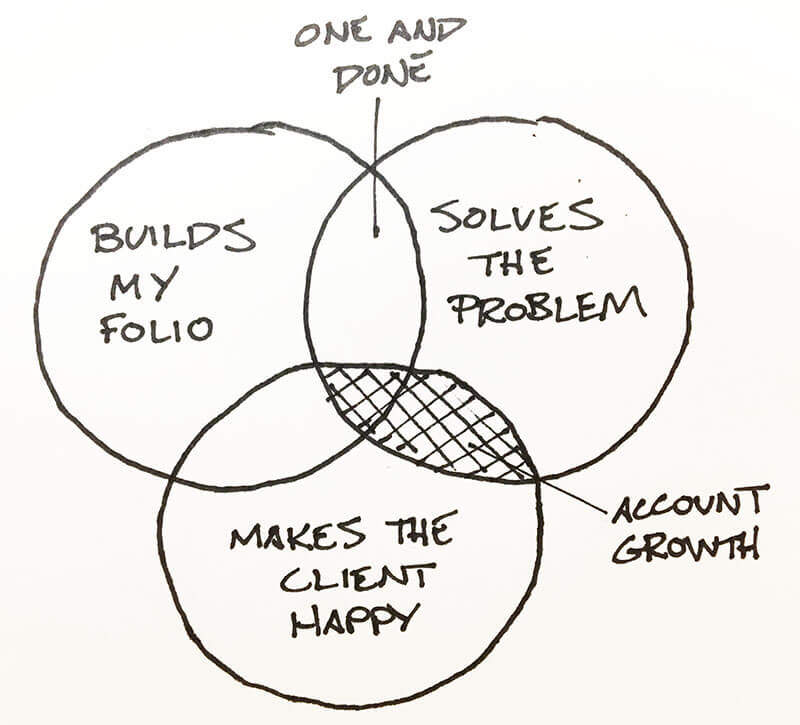Many consulting businesses are formed by entrepreneurs with exceptional design talent. These fine men and women have made their name with an eye for design and by delivering strong work for big name brands. They’ve ascended through the creative and marketing ranks because of their ability to produce beautiful concepts again and again.
However, some agencies struggle to grow because of trouble in the feedback and acceptance process. Clients aren’t loving the original concepts, and the downward spiral of feedback and revisions is:
- Lowering project profitability
- Lowering work quality
- Damaging relationships
It’s not the design. It’s not the client. The problem is that the design is not being sold effectively.
The notion “Good Design Sells Itself” is a fallacy. This may be true for the end user, but a concept will never see the light of day if it can’t first gain acceptance by the client. Agencies are usually formed around exceptional talent, not necessarily the ability of that talent to effectively manage the expectations of their audience or for the psychological theatre required to present design concepts for acceptance.
It’s important for an agency to collectively align in objective. What’s the mission behind their business? What drives the decision making process and gives them purpose? Are they driven to produce fine art, or are they excited to solve their client’s problems using design? There’s a huge difference there. If we agree that we want to try to solve the client’s problem in a way that makes them happy 100% of the time, then we’re also agreeing that we won’t always arrive at a solution that strokes our design ego. We need to move out of the “One and Done” mindset and into the “Account Growth” mindset.

The difference in moving from “One and Done” and into “Account Growth” is much more about how the client is managed than it is about the quality of the concepts. Chances are, your team has worked hard to arrive at a design where you feel confident in having solved the business problem. But this alone is not enough. The challenge now is in preparing the agency to put the right individuals with the right skills in front of client stakeholders. This may mean training the existing team to present effectively, or it may mean adding a new role entirely.
To exceed in presenting design concepts for acceptance, follow steps outlined below
- Document expectations from the beginning
- Identify decision-makers
- Include everyone
- Have an insider
- Control the environment of presentations
- Prepare the theatre
- Build up the story
- Solicit feedback and control the flow of conversation
1) Document expectations from the beginning
Even if project requirements are explicitly stated in a contract, kick off the project by sitting face to face with the client team to review the requirements.
It’s reasonable to insist that all project stakeholders are in attendance. This is the opportunity to note everything that must be included within the deliverables and who is responsible for each item. It’s also a great time to talk about how the work will be reviewed. What will be the criteria by which the client says they like it? The goal here is to eliminate as much subjectivity as possible.
2) Conduct proper Stakeholder Management
Ask the client who the decision makers will be throughout the project and specifically at the point of each major deliverable. This is an opportunity to identify everyone who will be weighing in with their opinion and to inform the client of dependencies within the approval cycle.
For example, participation by any stakeholder who is going to review and comment on the final design may be necessary within the requirements-gathering process or perhaps for a wireframe prototype review. It’s a good idea at this time to ask the client who has decision making authority. Will all comments carry equal weight, or will feedback bubble-up to one person for consideration. It’s not unreasonable to ask your client to only provide feedback that represents consensus of the organization. If you’ve never formally identified client roles before, a RACI matrix can help: https://en.wikipedia.org/wiki/Responsibility_assignment_matrix.
Within the identification of stakeholders, your agency should also privately assess the individuals involved and devise a strategy for success. Who may be playing coy but is really calling the shots? Who holds the keys to ongoing work with the organization? Who might be a saboteur? With larger client accounts this soap opera only gets more interesting.
3) Know the Saboteur
It’s not uncommon for projects to have a Saboteur on the client side, especially in large organizations. This person doesn’t necessarily have ill will toward your agency or toward their own organization. They may simply feel slighted by someone within their own organization or they may feel threatened by the expertise you bring as a contractor.
The best way to identify a potential Saboteur is to watch for negative body language cues in the early meetings of a project or reluctance to become involved in project communications. They will try to remain emotionally and organizationally distanced from the project. Once identified, the goal is to try to flip this person over to becoming an ally.
For example, if Jon is in charge of social media for the organization, he may feel threatened by losing some of his workload to your project. Try calling attention to his value in the planning stages by asking for his guidance and feedback when it comes to social integrations. If you involve a potential Saboteur early in the project and are genuine about valuing their subject matter expertise, it’s very likely that this person will become one of the greatest advocates for your agency and the solution you present for acceptance.
4) Have an insider
As much as you want to hold back the work until it’s perfect, your odds of smoother acceptance are higher if you share along the way. Identify one or more people within your client’s organization who have subject matter expertise or whose opinions are trusted by your key stakeholders. Bring them behind the curtain of your agency and involve them in structured critiques along the way. Someone in a marketing role usually works great for this. When it comes time for the big reveal, you find that this person helps you work the room to gain acceptance. More importantly, they’ll also keep working in your interest after you’ve left the room.
5) Control the environment of presentations
A common mistake made by agencies is having designers present their own work. Although some designers may be skilled presenters, most are not. Formal presentation of concepts to stakeholders is a big deal. Remember, the work doesn’t sell itself. The presenter should be an individual who knows not only the ins and outs of the work being presented, but also the project requirements, the success criteria, and the dynamic of stakeholders in the room.
It can often be beneficial for the hands-on designer to be absent from the room during presentation and feedback. This allows the presenter to objectively receive initial feedback and to respond candidly. It’s not uncommon for clients to hold back comments for fear of hurting a designer’s feelings, only to send a lengthy email after the fact with their unabashed criticism of the work.
It’s also important to present creative deliverables in-person. Not only will the presenter be more compelling to their audience, but they’ll also be able to read and react to the body language in the room. Additionally, in-person meetings create stronger personal connections which relate to overall account growth and longevity. A mature agency seizes any opportunity possible to get face time with a client.
6) Prepare for theatre
Presenting design takes preparation and craft. Your presenter should know the room they’re walking in to. Is the audience at a big long table, sitting on couches, or in a classroom style arrangement? Will you need to connect to a projector or monitor? If so, what resolution will it display and what’s your backup if you have connectivity issues? Your team should have walked through the presentation to know speaking roles, objectives, and to review stakeholder dynamics. Everyone attending from the agency should dress nicely and anyone presenting should stand up if possible. Professionalism reinforces credibility, which minimizes subjective feedback.
When presenting, take the time to set the stage. Briefly remind the audience (even if it’s a small, casual gathering) of the work done prior to the presentation. If there were lower fidelity versions of the concept that were previously presented, show those again and remind the audience of the agreed takeaways from those previous rounds.
7) Build up the story
Create a few precursor visuals to show the requirements and established success criteria. If there was research conducted which informed the creative concepts, show a few highlights from that material. Think of the presentation in terms of A+B=C. You want to articulate the backstory to the concept in a way where the audience can almost visualize the design before they see it. You demonstrate A and B such that C is the logical solution. Pause for just a moment before showing the work.
Was your build up effective? Your audience should be smiling.
8) Solicit feedback and control the flow of conversation
You have the floor when you present concepts. Utilize that position to control the in-room dialogue in a manner that benefits the project.
It’s a good idea to have the requirements and success criteria in a place where everyone can reference them. Go back to the A+B=C construct. Tell your audience that you’d like to get a general feel of what everyone thinks before getting into particulars.
In a large group this can be done by asking for a show of hands to general questions like, “who sees this concept as properly solving A+B?” In a smaller group, you can go around the room asking people for a 1-5 ranking of how well it solves the problem.
Let them know what we’ll go back around again to ask whether they personally like it. This first round of social commitment is very important. Once someone verbalizes a positive value statement, they’re unlikely to change their sentiment later when it’s socially easier to criticize through written feedback.
This is where your presenter will earn their keep. If stakeholders are concerned about the design, something went wrong along the way. It’s important for the presenter to dialogue with the stakeholder in real time to determine if there’s an incorrect or missing requirement, if they don’t feel that the material being presented is a correct solution to the problem, or if they’re inserting their own subjective dislike.
The presenter has a few avenues to address negative feedback, the strongest of which is to remind the audience that they are not the end user audience for the design concepts. If it’s coming down to a difference of opinion within the client-side group, proposing to test the concepts with a sample from the appropriate audience will usually resolve the disagreement. Our goal here is not to sell-in bad work. Our goal is to minimize the distraction of stakeholders’ personal preferences.
In Summary
1. Focus on the desired outcomes of a creative presentation
2. Select an individual with the most appropriate skill set to present
3. Prepare for the presentation knowing it’s success will impact the project scope
4. Understand the social factors within the meeting

